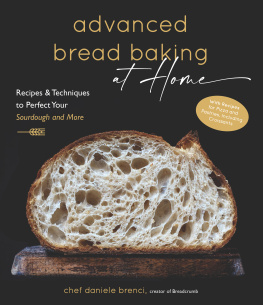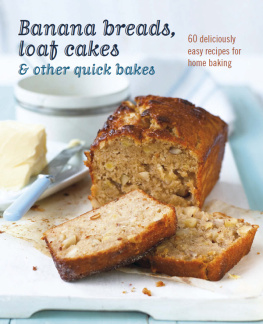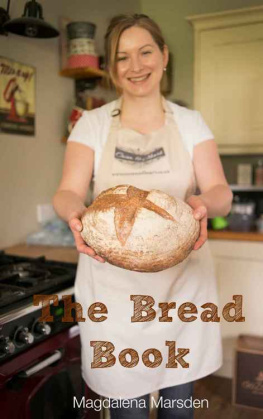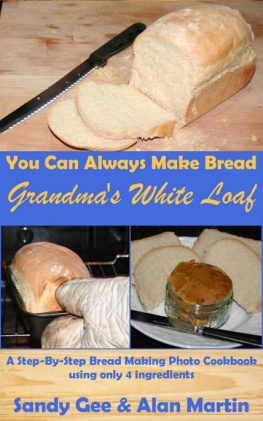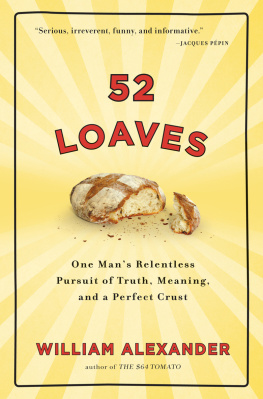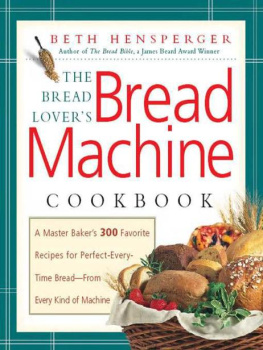Jason Daly - Use Your Loaf: How to bake bread at home and get perfect results
Here you can read online Jason Daly - Use Your Loaf: How to bake bread at home and get perfect results full text of the book (entire story) in english for free. Download pdf and epub, get meaning, cover and reviews about this ebook. year: 2014, publisher: Jason Daly, genre: Home and family. Description of the work, (preface) as well as reviews are available. Best literature library LitArk.com created for fans of good reading and offers a wide selection of genres:
Romance novel
Science fiction
Adventure
Detective
Science
History
Home and family
Prose
Art
Politics
Computer
Non-fiction
Religion
Business
Children
Humor
Choose a favorite category and find really read worthwhile books. Enjoy immersion in the world of imagination, feel the emotions of the characters or learn something new for yourself, make an fascinating discovery.

- Book:Use Your Loaf: How to bake bread at home and get perfect results
- Author:
- Publisher:Jason Daly
- Genre:
- Year:2014
- Rating:3 / 5
- Favourites:Add to favourites
- Your mark:
- 60
- 1
- 2
- 3
- 4
- 5
Use Your Loaf: How to bake bread at home and get perfect results: summary, description and annotation
We offer to read an annotation, description, summary or preface (depends on what the author of the book "Use Your Loaf: How to bake bread at home and get perfect results" wrote himself). If you haven't found the necessary information about the book — write in the comments, we will try to find it.
Jason Daly: author's other books
Who wrote Use Your Loaf: How to bake bread at home and get perfect results? Find out the surname, the name of the author of the book and a list of all author's works by series.
Use Your Loaf: How to bake bread at home and get perfect results — read online for free the complete book (whole text) full work
Below is the text of the book, divided by pages. System saving the place of the last page read, allows you to conveniently read the book "Use Your Loaf: How to bake bread at home and get perfect results" online for free, without having to search again every time where you left off. Put a bookmark, and you can go to the page where you finished reading at any time.
Font size:
Interval:
Bookmark:
Use your Loaf:
How to bake bread athome and get perfect results
By
Jason Daly
Text copyright 2013Jason Daly
All Rights Reserved
Contents
BREAD IS THE STAFF OF LIFE

Orso the saying goes. Bread is a staple part of the modern Western diet. Many ofus eat a lot of bread but only a few ever try their hand at baking their own.Why is this? Is it because it is deemed to be too difficult? Too timeconsuming? Too technical? In all honesty it is probably a combination of allthree. But I think the fact that mass produced bread is so readily availableand relatively inexpensive (or was!) is a major factor in todays high speedsociety. The thing is; mass produced bread doesnt taste that good! I thinkthat anyone, once they have tried freshly baked, still-warm, handmade breadwill agree. Mass produced bread isnt bad, it just isnt that good!
Breadcomes in many shapes and sizes: bloomer, baguette, brioche, ciabatta, cobber,chapatti, roti, sourdough to name a few, but in reality there are two kind ofbread handmade and not handmade (mass produced).
In1961 the Chorleywood Bread Process was developed and this revolutionisedbaking. A high speed mechanical mixing process was devised and this allowedreduced fermentation times. It also meant that they could now use British wheatwhich was cheaper than American wheat but also had a lower protein content.
Theyalso started adding chemical stabilisers, flavour enhancers and antifungalsas well as hydrogenated fats. All this had 1 result in mind: maximum efficiencyfor maximum profit.
Itis almost certain that this kind of bread worse for you. As well as all theadditives and fats, the short fermentation results in wheat that is actuallyharder to digest and there is some belief that the whole process may be behindthe increase in gluten intolerance and allergy.
Itis estimated that up to 98% of bread in the UK is mass produced and most comefrom a dozen or so huge plant bakeries. And do not be fooled by your supermarketin-store bakery as they are just smaller versions of these plants. Even mostlocal bakeries are guilty of this. Put it this way, if the bread in your localbakery looks like everyone elses (the ubiquitous flat topped white tin loaf),the chances are it was produced the same way.
Realbakeries are magical places. Here bread will be hand baked on site in smallbatches. It is easy to tell hand baked bread as it wont look like the breadfound in other stores. Some may sell their bread to other local shops which isgreat. Unfortunately real bakeries are scarce so if you are lucky enough tohave access to one, then use it! The bread will be a little more expensive andrightly so!
Theother alternative is to make your own handmade bread at home, and I hope thatby buying this guide you have taken that important decision to give it a go. Ifyou are still not convinced, look at the simple economics. A large home-bakedloaf can cost less than half the price of mass produced supermarket bread. Toillustrate this, it costs me 55p (ingredients, gas/electric) to produce a large800g loaf. At the time of writing, the supermarket in-store bakery loaf cost1.10, the local shop cost 1.30 and the local bakery cost 1.60! As you cansee profit margins are high and they would be even higher with commercialbuying power driving down the cost of the ingredients.
So get your apron on, dust your handswith flour and get baking. I assure you, you will never look back.

What equipment will I need?
The good thing about baking your own bread is that you dontreally need any specialist kit. If you already bake cakes and pastries chancesare you have everything essential that you need:
A large mixing bowl
Measuring jug
Rolling pin
Kitchen scales
Palette knife
Pastry knife
Bread knife
Wire cooling rack
Baking tray (the heavier the better)
Black bin bags!
Spray bottle
You will also need some linen cloths or all linen tea-towels.Linen draws very little moisture so your dough should never stick to a wellfloured linen cloth. Alternatively you could sit your dough on a woodenchopping board or even a piece of plywood.
Optional extras include loaf tins, proving baskets, a bakingstone (plus peel) and a food processor with a dough hook. Proving baskets comein various shapes and sizes and can be cheap (wicker or plastic) or quiteexpensive (cane and usually linen lined).
Without a doubt, the best way to bake bread is on a bakingstone. You can use a pizza stone which is available in many kitchen shops, butit would be better if you measure your oven and go and buy the best fittingpaving stone you can find. If you do use a stone you will need a peel which isbasically a type of shovel a sheet of wood or metal with a handle. It is usedto slide bread onto your baking stone in the oven. Either buy one or make one.
If you dont use a baking stone, use the heaviest bakingtray you have, and you wont need the peel either as this can be taken out ofthe oven.
Iuse a spray bottle to spray my dough with water before it goes into the oven.
Ifthe thought of kneading fills you with dread, you could opt to use a foodprocessor with a dough hook attachment. In fact they can be very useful whenworking with very wet dough such as ciabatta.
Whatingredients will I need?
Bread only has four basic ingredients although others canbe added. The four main ingredients are flour, yeast, salt and water.
Flour is by far the most important ingredient so try to buy the best organic flouryou can afford. Wheat prices have soared recently, but remember, the cost of aloaf made at home is roughly half that of shop bought bread.
Check for anyadditives especially with white flour, as they may have bleaching agents addedto make them whiter how pointless! If you can find it, organic stonegroundflour is best.
Wheatflour is the most common type of flour in the UK. A grain of wheat is actuallya seed consisting of 3 parts: bran, germ and endosperm. The bran is the toughouter skin, the germ is the embryonic wheat plant and the endosperm is used asa food source by the germ in early development. The bran is a rich source ofprotein, the germ a good source of vitamins, and the endosperm a great sourceof carbohydrates, plus some protein, minerals and oil.
Youmay be thinking, So what! Why is he telling me this? Well, all thesecomponents have an effect on the bread making process. Plus, I think itsimportant to understand what is going on during the process, and in this wayyou will give the whole task more respect. Also, understanding what your kneadingis doing will almost certainly make you a better baker.
So,the carbohydrates are used as fuel by the yeast, the proteins bond to form theall important gluten strands, and the minerals are used to strengthen thegluten strands. The oil helps to maintain moisture thus keeping your breadsofter for longer.
Delvinga bit deeper into the science of bread making (sorry!), something happens whenwater is added to flour and that is the formation of gluten. Gluten is formedby the bonding of two proteins, gliadin and glutenin. Gluten is an elasticprotein that can be really stretched to form long strands. The more it isworked, the longer and stretchier it becomes. These strands form a complex meshwhich helps to trap carbon dioxide bubbles produced by yeast, thus creating gasbubbles inside your dough. This is the process you are encouraging whenkneading your dough, so as you can hopefully appreciate, well kneaded dough isa prerequisite for a well formed loaf.
Font size:
Interval:
Bookmark:
Similar books «Use Your Loaf: How to bake bread at home and get perfect results»
Look at similar books to Use Your Loaf: How to bake bread at home and get perfect results. We have selected literature similar in name and meaning in the hope of providing readers with more options to find new, interesting, not yet read works.
Discussion, reviews of the book Use Your Loaf: How to bake bread at home and get perfect results and just readers' own opinions. Leave your comments, write what you think about the work, its meaning or the main characters. Specify what exactly you liked and what you didn't like, and why you think so.

